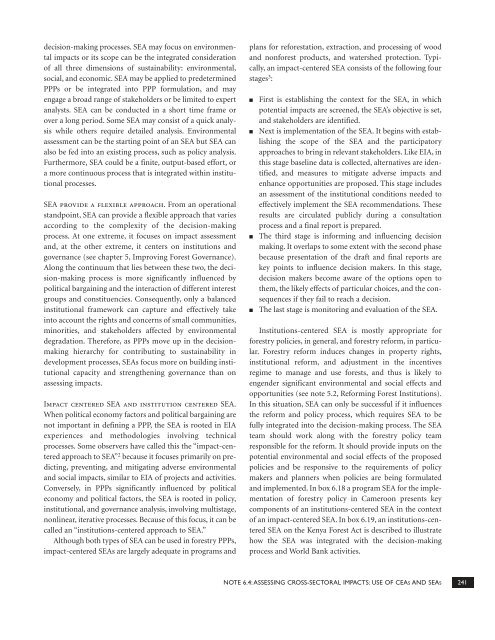Forests Sourcebook - HCV Resource Network
Forests Sourcebook - HCV Resource Network
Forests Sourcebook - HCV Resource Network
You also want an ePaper? Increase the reach of your titles
YUMPU automatically turns print PDFs into web optimized ePapers that Google loves.
decision-making processes. SEA may focus on environmental<br />
impacts or its scope can be the integrated consideration<br />
of all three dimensions of sustainability: environmental,<br />
social, and economic. SEA may be applied to predetermined<br />
PPPs or be integrated into PPP formulation, and may<br />
engage a broad range of stakeholders or be limited to expert<br />
analysts. SEA can be conducted in a short time frame or<br />
over a long period. Some SEA may consist of a quick analysis<br />
while others require detailed analysis. Environmental<br />
assessment can be the starting point of an SEA but SEA can<br />
also be fed into an existing process, such as policy analysis.<br />
Furthermore, SEA could be a finite, output-based effort, or<br />
a more continuous process that is integrated within institutional<br />
processes.<br />
SEA provide a flexible approach. From an operational<br />
standpoint, SEA can provide a flexible approach that varies<br />
according to the complexity of the decision-making<br />
process. At one extreme, it focuses on impact assessment<br />
and, at the other extreme, it centers on institutions and<br />
governance (see chapter 5, Improving Forest Governance).<br />
Along the continuum that lies between these two, the decision-making<br />
process is more significantly influenced by<br />
political bargaining and the interaction of different interest<br />
groups and constituencies. Consequently, only a balanced<br />
institutional framework can capture and effectively take<br />
into account the rights and concerns of small communities,<br />
minorities, and stakeholders affected by environmental<br />
degradation. Therefore, as PPPs move up in the decisionmaking<br />
hierarchy for contributing to sustainability in<br />
development processes, SEAs focus more on building institutional<br />
capacity and strengthening governance than on<br />
assessing impacts.<br />
Impact centered SEA and institution centered SEA.<br />
When political economy factors and political bargaining are<br />
not important in defining a PPP, the SEA is rooted in EIA<br />
experiences and methodologies involving technical<br />
processes. Some observers have called this the “impact-centered<br />
approach to SEA” 2 because it focuses primarily on predicting,<br />
preventing, and mitigating adverse environmental<br />
and social impacts, similar to EIA of projects and activities.<br />
Conversely, in PPPs significantly influenced by political<br />
economy and political factors, the SEA is rooted in policy,<br />
institutional, and governance analysis, involving multistage,<br />
nonlinear, iterative processes. Because of this focus, it can be<br />
called an “institutions-centered approach to SEA.”<br />
Although both types of SEA can be used in forestry PPPs,<br />
impact-centered SEAs are largely adequate in programs and<br />
plans for reforestation, extraction, and processing of wood<br />
and nonforest products, and watershed protection. Typically,<br />
an impact-centered SEA consists of the following four<br />
stages 3 :<br />
■<br />
■<br />
■<br />
■<br />
First is establishing the context for the SEA, in which<br />
potential impacts are screened, the SEA’s objective is set,<br />
and stakeholders are identified.<br />
Next is implementation of the SEA. It begins with establishing<br />
the scope of the SEA and the participatory<br />
approaches to bring in relevant stakeholders. Like EIA, in<br />
this stage baseline data is collected, alternatives are identified,<br />
and measures to mitigate adverse impacts and<br />
enhance opportunities are proposed. This stage includes<br />
an assessment of the institutional conditions needed to<br />
effectively implement the SEA recommendations. These<br />
results are circulated publicly during a consultation<br />
process and a final report is prepared.<br />
The third stage is informing and influencing decision<br />
making. It overlaps to some extent with the second phase<br />
because presentation of the draft and final reports are<br />
key points to influence decision makers. In this stage,<br />
decision makers become aware of the options open to<br />
them, the likely effects of particular choices, and the consequences<br />
if they fail to reach a decision.<br />
The last stage is monitoring and evaluation of the SEA.<br />
Institutions-centered SEA is mostly appropriate for<br />
forestry policies, in general, and forestry reform, in particular.<br />
Forestry reform induces changes in property rights,<br />
institutional reform, and adjustment in the incentives<br />
regime to manage and use forests, and thus is likely to<br />
engender significant environmental and social effects and<br />
opportunities (see note 5.2, Reforming Forest Institutions).<br />
In this situation, SEA can only be successful if it influences<br />
the reform and policy process, which requires SEA to be<br />
fully integrated into the decision-making process. The SEA<br />
team should work along with the forestry policy team<br />
responsible for the reform. It should provide inputs on the<br />
potential environmental and social effects of the proposed<br />
policies and be responsive to the requirements of policy<br />
makers and planners when policies are being formulated<br />
and implemented. In box 6.18 a program SEA for the implementation<br />
of forestry policy in Cameroon presents key<br />
components of an institutions-centered SEA in the context<br />
of an impact-centered SEA. In box 6.19, an institutions-centered<br />
SEA on the Kenya Forest Act is described to illustrate<br />
how the SEA was integrated with the decision-making<br />
process and World Bank activities.<br />
NOTE 6.4:ASSESSING CROSS-SECTORAL IMPACTS: USE OF CEAS AND SEAS 241

















